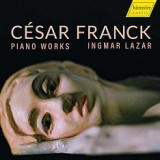César Franck komponierte seine Erste Klaviersonate op. 10 in den Jahren 1834/35, als er knapp dreizehn Jahre alt war. Sie ist klassisch in der Form, romantisch im Ausdruck und von ihrer Melodik her durchaus charakteristisch. Der französische Pianist Ingmar Lazar spielt sie sehr einfühlsam und nach dem kontrastreichen ersten Satz, Larghetto Allegretto, folgen ein liebliches Adagio und danach ein charmantes Rondo. Der virtuose Grand Caprice spielt Lazar ebenfalls sehr ausdrucksvoll.
Auch die beiden späten Stücke Prélude, choral et fugue und Prélude, aria et final erklingen in hervorragenden Interpretationen. Lazars Spiel ist sehr differenziert und unterstreicht auf bewundernswerte Weise die singenden Linien und die Poesie der Melodien. Keine hohle Sentimentalität trübt diese Klänge mit ihrer perfekten rhythmischen Strenge und den extrem gut kontrollierten und immer rhetorischen An- und Entspannungsbewegungen. Lazar kann auch sehr viel Kraft aufbringen, wenn die Partitur es verlangt, z.B. im letzten Satz von Präludium, Arie und Finale.
Der Klang des Klaviers ist gut eingefangen, voll und vollkommen natürlich.
César Franck composed his First Piano Sonata op. 10 in 1834/35, when he was barely thirteen years old. It is classical in form, romantic in expression and quite characteristic in its melodicism. French pianist Ingmar Lazar plays it very sensitively and after the contrasting first movement, Larghetto Allegretto, there follows a lovely Adagio and then a charming Rondo.
Lazar also plays the virtuosic Grand Caprice very expressively.
The two late pieces Prélude, choral et fugue and Prélude, aria et final are also heard in excellent interpretations. Lazar’s playing is highly differentiated and admirably underscores the singing lines and poetry of the melodies. No hollow sentimentality tarnishes these sounds, with their perfect rhythmic rigor and extremely well-controlled and always rhetorical attack and release movements. Lazar can also muster a great deal of power when the score demands it, for example in the last movement of the Prelude, Aria and Finale.
The sound of the piano is well captured, full and perfectly natural.
























